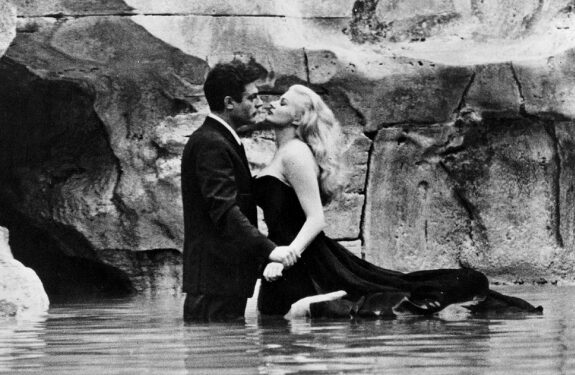“La Dolce Vita” (1960), directed by Federico Fellini, is a masterpiece of Italian cinema that perfectly captures the decadence and spiritual emptiness of Rome’s high society in the post-war economic boom. The film follows Marcello Rubini, a tabloid journalist played brilliantly by Marcello Mastroianni, as he drifts through the eternal city’s nightlife, pursuing stories and pleasure in equal measure.
The film’s opening sequence remains one of cinema’s most iconic moments: a helicopter carries a statue of Christ over Rome while reporters, including Marcello, follow in another helicopter. This striking image sets up the film’s central conflict between the sacred and the profane, spirituality and hedonism.
Through a series of loosely connected episodes, Fellini paints a portrait of a society in moral decline. Marcello encounters various characters who embody different aspects of “the sweet life”: Maddalena, a wealthy heiress seeking meaning through casual affairs; Sylvia (played by Anita Ekberg), a voluptuous American movie star who creates a media sensation by frolicking in the Trevi Fountain; and Steiner, an intellectual whose seemingly perfect life masks deep despair.
The film’s episodic structure mirrors the fragmentary nature of modern life and the protagonist’s inability to find lasting meaning or connection. Each segment becomes progressively darker, moving from the relative innocence of early scenes to more disturbing episodes, including Steiner’s tragic murder-suicide and the film’s famous decadent parties.
Fellini’s visual style is at its peak here, with stunning black-and-white cinematography that captures both the glamour and the grotesque nature of Roman high society. The director’s signature blend of realism and symbolism creates unforgettable images that have influenced filmmakers for generations.
“La Dolce Vita” also marked a significant shift in Fellini’s career, moving away from his neorealist roots toward a more personal, symbolic cinema. The film coined the term “paparazzo” (named after Marcello’s photographer friend Paparazzo) and captured the emerging celebrity culture that would become increasingly prevalent in the decades to follow.
The film’s final scene, where Marcello encounters a mysterious young woman on the beach but can no longer hear or understand her innocent words across the distance, serves as a powerful metaphor for his spiritual condition. He has become too corrupted by “the sweet life” to reconnect with purity and authenticity.
More than six decades after its release, “La Dolce Vita” remains a powerful critique of modern society’s spiritual emptiness and the endless pursuit of pleasure that leads nowhere. Its themes of alienation, celebrity culture, and the search for meaning in a materialistic world are perhaps even more relevant today than when the film was first released.
newshub



Recent Comments